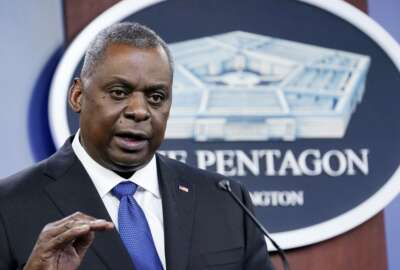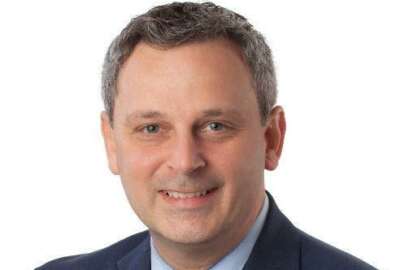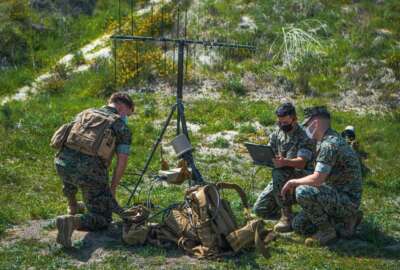An experienced DoD acquisition and contracting hand is now steering a professional organization
The National Contract Management Association has a new president - retired Air Force Lieutenant General and former director of the Defense Contract Management...
Best listening experience is on Chrome, Firefox or Safari. Subscribe to Federal Drive’s daily audio interviews on Apple Podcasts or PodcastOne.
The National Contract Management Association has a new president-elect. The organization, with thousands of federal practitioners and contractors as members, has chosen for this year’s president, retired Air Force Lieutenant General and former director of the Defense Contract Management Agency, Wendy Masiello. She joined Federal Drive with Tom Temin to discuss.
Interview transcript:
Tom Temin: General Masiello, good to have you on.
Lt. Gen. Wendy Masiello: Hi, Tom. Thank you. I’m glad to be here.
Tom Temin: And you come to this with quite a background. I consider acquisition the beginning of contract management, I guess maybe contract management is something that follows on the completion of the acquisition, but it’s really kind of a continuous effort – isn’t it?
Lt. Gen. Wendy Masiello: Contracting is from beginning to end, it’s when you start strategizing the acquisition and figuring out what you’re going to need to put down on paper in the context of the contract, all the way to redistributing property that might have been purchased under that contract once everything is complete.
Tom Temin: Let’s get to the bigger issue of the acquisition and procurement challenges. The Biden administration has some refreshed policies with respect to what they call equity and also climate change as factors in a wide range of acquisitions. What are the challenges there that you see that the professionals and government doing this in the next year or two are gonna face?
Lt. Gen. Wendy Masiello: I’m not sure what they might be yet, Tom. I think the thing that’s nice in the executive orders is it gives each of the agencies an opportunity to do an assessment of their current policies and processes and procedures to determine where barriers might still exist with regard to equity or climate change mitigation. They’re in that process now. As they go through that and come to a better understanding, we’ll all better then know what the next steps are, and have a better idea on what the impacts might be as we go forward.
Tom Temin: But it’s going to come down to the individual contracting officers at some point to make sure that whatever the agency’s posture on policy is, it gets expressed through what those individuals do day to day – doesn’t it?
Lt. Gen. Wendy Masiello: Absolutely. So understanding what the risks are, pushing the new guidance policies and procedures out, making sure that they are very clear in the processes, constructing contracting tools to get there, making sure the advertisements are clear and creating acquisition strategies that support those – will all be part of pushing that out in a consistent manner.
Tom Temin: And in doing so, is it possible to glean from industry some of the practices it has in its own acquisition and purchasing and procurement that could be adopted to government? Maybe some of that work is already done.
Lt. Gen. Wendy Masiello: You’re absolutely right. As I watch, particularly in the public industry, those that are under the SEC guidance are moving very rapidly in the context of equity and climate change under the context of ESG (environmental, social, and governance) standards. And they’re getting help with the SEC task force it’s just put in place to enforce climate and ESG issues. So it’s been fascinating to watch how rapidly the companies to our public companies are responding to the demands for equity and climate change mitigation.
Tom Temin: And in your old stomping ground, the Defense Department, it’s a big issue because if nothing else, the effects of climate change or the purported effects certainly have impact on Defense facilities physically.
Lt. Gen. Wendy Masiello: Absolutely. So it’s the facilities that they’re constructing. And you look at Tyndall and their attempt to create a smart city essentially down there in Tyndall in the wake of the hurricane. So I do see that there are opportunities that the Defense Department is looking to take advantage of the issues important in climate change, and figuring out ways to build that into their constructs. So there are little models that are going to be out there that others can take advantage of.
Tom Temin: And I was glancing through the agenda for the NCMA upcoming World Congress, which is really a great event. I’ve been to it a few times. And the supply chain issues in cybersecurity specifically seem to be one of the animating factors in the agenda. And so what do you think of the chief challenges in contract management, especially as they affect the supply chain security? There’s the CMMC program, but quite a few other initiatives going on in that whole area.
Lt. Gen. Wendy Masiello: You’re right, Tom. CMMC is still a big issue, primarily for the small contractors. The small businesses are really struggling with what does it mean. No one argues that cyber security concerns are not an issue. We see that as a byproduct of just even the recent Colonial Pipeline initiative. So everybody understands that it’s important, but there’s cost and they’re rapidly evolving issues and changes to what those attacks look like. And it is a constant issue, it’s so constantly evolving that the small businesses in particular are really struggling with how to protect their systems, how to buy their products. And of course, many of the contractors are still dealing with the whole concept of what appeared to be competing issues in DoD acquisition that include competition, you still need to do competition, but a push towards commercialization and using innovative contractors and the non traditional contractors who don’t operate in the same types of cyber concern issues that many of the Defense contractors have figured out how to embrace.
Tom Temin: And then there’s the other transaction authority, the OTA, which is really a growing area for DoD and several other agencies, an old tool recently polished and sharpened. And I wonder if that’s going to be drawing congressional scrutiny at some point when they see the types of things DoD might be buying with OTA.
Lt. Gen. Wendy Masiello: Well, I think you’re right. I think that OTA when you take it off of the mainstream tools and processes, there’s less visibility into what OTAs are offering. I’m not saying it’s a good tool, I’m not saying it’s the right thing at the right time. But when you do take it off as a traditional data collection point, and when you do take it off the traditional transparency and move it into an OTA construct, it changes what you know about what’s being done.
Tom Temin: So proceed with caution in other words.
Lt. Gen. Wendy Masiello: Exactly.
Tom Temin: Alright. We’re speaking with retired Air Force Lieutenant General Wendy Masiello, president-elect of the National Contract Management Association. And switching gears for a moment, just by coincidence, this week a report came out from the National Academy of Sciences empowering the Defense acquisition workforce to improve mission outcomes using data science. You were co-chair of the committee that created that report. Tell us what’s in there.
Lt. Gen. Wendy Masiello: It’s an assessment of what industry and academia are doing in the context of data, application of data and managing data. And that’s filing their workforces to understand and appreciate it, and what can be gleaned from those experience in those areas to be applicable for the Defense acquisition workforce. You will find in our report a very similar statement to one that just came out in Deputy Secretary Defense Hicks’ document about creating data advantage that data is a strategic asset. And it’s how do we harness our workforce and prepare our workforce to embrace data in a way that they never anticipated?
Tom Temin: Yeah. Give us an example of how that might work. Because that’s, I mean, in some sense, they’ve always used pricing history and vendor performance history. Some of that is hard data, some of that is assessment. But what are the new types of data that are available that are coming into this whole field?
Lt. Gen. Wendy Masiello: I think that, Tom, if you just look at the whole concept of digital acquisition, and the Air Force in particular has been very active about talking about digital acquisition, as well as in the Space Force – it can begin with something as simple as an electronic design. And by doing an electronic design of an aircraft, building and testing that in electronic tools to understand what the components are to build and operate that particular weapon system. And then building it and assembling it without doing any kind of handwork. It’s amazing what can come out of that if you can design an aircraft electronically and build it, you have everything from day one what the components of that particular aircraft are. So when you change or modify or add anything to the aircraft over the lifetime, you already know what the baseline is. And it actually even helps you better sustain it over time when parts become obsolete. It’s a huge vision for a long term approach to how we can change what we do. So it’s not just looking at cost data from a historical perspective, but design, modification, integration, and being able to test it all in a digital realm that we’ve never ever anticipated and is now just beginning to become available.
Tom Temin: It sounds like maybe statistical analysis could come into a lot of types of procurement decisions, almost the way it has come into the world of sports.
Lt. Gen. Wendy Masiello: Absolutely, without a doubt. And it’s how do we prepare a workforce? How do we give them the tools to do that? What does it take to move us in that direction? The talent that our current universities are kicking out as data scientists, it’s remarkable the tools that accelerate our ability to understand data, to visualize data are so remarkable that I remember that I studied bar charts and pie charts as a way to visualize data. And now we have multi dimensional ways of visualizing data to make sense out of it. Data is important, but the tools that extract the information you need to make decisions are what make the data important for us today.
Tom Temin: And I guess for the workforce itself then, knowing the questions you need to ask that could be informed by data – and then you can use the data in some intelligent way other than being overwhelmed by it.
Lt. Gen. Wendy Masiello: Exactly. And it’s also even knowing what data you have available. It’s an appreciation that when you do and manage data, the importance of getting it right, because it feeds decisions down the process. It’s how do I look at the data? How do I interpret it? How do I trust the data? How do I know the data I’ve collected is sound, that it’s consistently understood? It’s a huge lifecycle of understanding, and the report talks about data life cycles, it talks about the types of skill that the acquisition workforce will look at and take advantage of in order to learn how to use data and extract the information for decision making to inform their decisions over time.
Tom Temin: And there was a position in the world called the contracting officers representative, the COR. Can you envision perhaps a CODE, a contracting officers data executive or something coming next?
Lt. Gen. Wendy Masiello: Well, I think that under the context of the CDOs that are being established across the Department of Defense, the Chief Data Officers, they’ll set standards for data. Contracting professionals actually use analysts and have for a long time. This is so much bigger than just the data on dollars, the data on historical contracts, the data on the people and the companies who have done business for us. This is rethinking entirely the output of our acquisition system and informing things much more rapidly in a different way. But you’re absolutely right, I think what it means is we’re gonna actually build teams, and much like a good, strong, powerful acquisition team that’s innovative and thoughtful – it’s a multifunctional team that brings different skill sets to the table. And that is exactly how the data analysts and the data ecosystem operates. There are data engineers, there are analysts, there are curators of data, there are data scientists that bring different perspectives to how to look at data, how to manage data. And a key component of that are the people who understand the work that’s being done. For example, the contracting officers, who bring a huge understanding of what might be called the domain expertise. So that domain expert, whether it’s a contracting person, whether it’s a project manager, whether it’s a design engineer, are all part of this data ecosystem that will help us make better decisions at the speed of relevance, in a way we never, never thought we’d be able to do.
Tom Temin: Sounds like an exciting time to be in the contracting and acquisition and contract management field.
Lt. Gen. Wendy Masiello: I think it is, if you have time to think about it. And I always worry about our workforce, because as you know, we have a whole continuum of talent and expertise and experience – and we also struggle with time. So I’m super excited about what the opportunity does, because I think if we can better use data to inform our decisions and learn how to capture it and translate it into information, we can move faster, that allows us to move at that speed of relevance. It is a big elephant. And we have a very large Defense acquisition community. And to get everybody prepared is a an enormous task. So it’ll be incumbent upon DoD to really target that initiative, and apply those talents really and best where you can and where it’s going to make the biggest bang for the buck over time. But I am super excited about what it can mean for Defense acquisition and our warfighters, and getting good products to the warfighters faster, and helping our acquisition workforce find ways to do that through data.
Tom Temin: Retired Air Force Lieutenant General Wendy Masiello is president-elect of the National Contract Management Association. Thanks so much for joining me.
Lt. Gen. Wendy Masiello: My pleasure Tom, thank you for having me.
Copyright © 2025 Federal News Network. All rights reserved. This website is not intended for users located within the European Economic Area.
Tom Temin is host of the Federal Drive and has been providing insight on federal technology and management issues for more than 30 years.
Follow @tteminWFED






